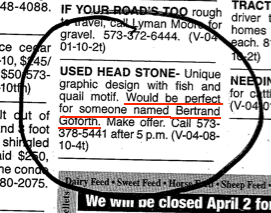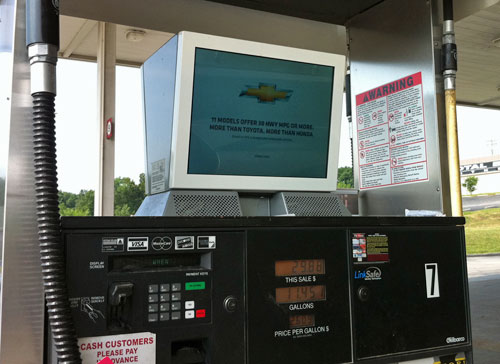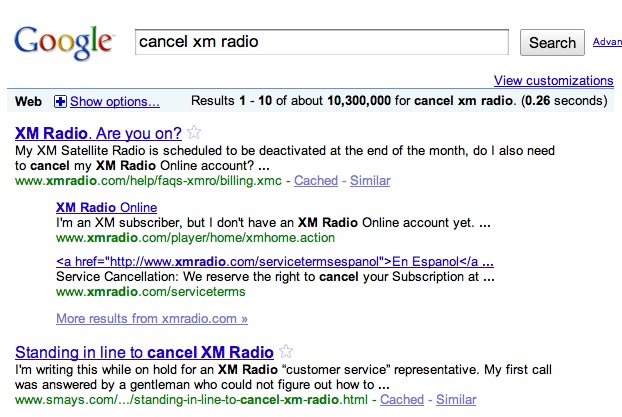My first look at GSTV (Gas Station TV) was at a Phillips 66 station on I-55. It probably took me no longer than 3 or 4 minutes to fill up and I guess there really isn’t much to do with that time, so why not. There were these really short sports/weather/news segments with commercial messages between each. Really can’t imagine someone paying for these but they obviously do. I foresee a time when we pay a premium to AVOID being hammered by ads. Ransom Ads.
Category Archives: Business & Marketing
M7 Are you talking to me?
War by Sebastian Junger
 Sebastian Junger was recently a guest on The Daily Show but you really don’t get much of a feel for a book (or the author) from those segments. Not sure why I picked up War but it’s hard to put down.
Sebastian Junger was recently a guest on The Daily Show but you really don’t get much of a feel for a book (or the author) from those segments. Not sure why I picked up War but it’s hard to put down.
The war in Afghanistan seems very… abstract to me. I know it’s going on and people are dying (although we see almost no images of that) but it doesn’t seem real. Junger’s book (and the documentary, I assume) makes it seem very real.
I can’t tell if Junger has any views about whether the war is right or wrong or if that’s even a relevant question from the perspective the people fighting it. But his account makes it difficult to imagine anything like “winning.”
“The fact that networks of highly mobile amateurs can confound –even defeat– a professional army is the only thing that has prevented empires from completely determining the course of history. You can’t predict the outcome of a war simply by looking at the numbers.” – page 83
“The moral basis of the war doesn’t seem to interest soldiers much, and its long-term success or failure has a relevance of almost zero. Soldiers worry about those things about as much as farmhands worry about the global economy, which is to say, they recognize stupidity when it’s right in front of them but they generally leave the big picture to others.” – page 25
“…at one mile out (an) aircraft carrier is the size of a pencil eraser held at arm’s length. The plane covers that distance in thirty-six seconds and must land on a section of flight deck measuring seven yards wide and forty-five yards long.” – page 34
“…he joined the Army because he was tired of partying and living at this mother’s house, and now he’s behind sandbags on a hilltop in Afghanistan getting absolutely rocked.” – page 67
“Once while leaning against some sandbags I was surprised to feel some dirt fly in my face. It didn’t make any sense until I heard the gunshots a second later. How close was that round? Six inches? A foot?” – page 71
“It certainly isn’t beautiful up there, but the fact that it might be the last place you’ll ever see does give it a kind of glow.” – page 71
“The problem with fear, though, is that it isn’t any one thing. Fear has a whole taxonomy — anxiety, dread, panic, foreboding — and you could be braced for one form and completely fall apart facing another.” – page 73
“If I had any illusions about personal courage, they dissolved in the days or hours before something big, dread accumulating in my blood like some kind of toxin until I felt too apathetic to even tie my boots properly.” – page 74
“There are different kinds of strength, and containing fear may be the most profound, the one without which armies couldn’t function and wars couldn’t be fought (God forbid).” – page 74
“…an enormous amount of war-fighting simply consists of carrying heavy loads uphill.” – page 75
“If you’re not prepared to walk for someone you’re certainly not prepared to die for them, and that goes to the heart of whether you should even be in the platoon.” – page 77
“(He) had some kind of crazy redneck strength that was more like hydraulics than musculature.” – page 75
“The fact that networks of highly mobile amateurs can confound –even defeat– a professional army is the only thing that has prevented empires from completely determining the course of history. You can’t predict the outcome of a war simply by looking at the numbers.” – page 83
A “Vietnam moment” was one in which you weren’t so much getting misled as getting asked to participate in a kind of collective wishful thinking.” – page 132
“…much of modern military tactics is geared toward maneuvering the enemy into a position where they can essentially be massacred from safety. It sounds dishonorable only if you imagine that modern war is about honor; it’s not. It’s about winning, which means killing the enemy on the most unequal terms possible. Anything less simply results in the loss of more of your own men.” – page 140
“The enemy now had a weapon that unnerved the Americans more than small-arms fire ever could: random luck. Every time you drove down the road you were engaged in a twisted existential exercise where each moment was the only proof you’d ever have that you hadn’t been blown up the moment before.” – page 142
“War is a lot of things and it’s useless to pretend exciting isn’t one of them. It’s insanely exciting. The machinery of war and the sound it makes and the urgency of its use and the consequences of almost everything about it are the most exciting things anyone engaged in war will ever know.”
“War is supposed to feel bad because undeniably bad things happen in it, but for a nineteen-year-old at the working end of a .50 cal during a firefight that everyone comes out of okay, war is life multiplied by some number that no one has ever heard of.” – page 144
“The moral basis of the war doesn’t seem to interest soldiers much, and its long-term success or failure has a relevance of almost zero. Soldiers worry about those things about as much as farmhands worry about the global economy, which is to say, they recognize stupidity when it’s right in front of them but they generally leave the big picture to others.” – page 25
“…at one mile out (an) aircraft carrier is the size of a pencil eraser held at arm’s length. The plane covers that distance in thirty-six seconds and must land on a section of flight deck measuring seven yards wide and forty-five yards long.” – page 34
“…he joined the Army because he was tired of partying and living at this mother’s house, and now he’s behind sandbags on a hilltop in Afghanistan getting absolutely rocked.” – page 67
“Once while leaning against some sandbags I was surprised to feel some dirt fly in my face. It didn’t make any sense until I heard the gunshots a second later. How close was that round? Six inches? A foot?” – page 71
“It certainly isn’t beautiful up there, but the fact that it might be the last place you’ll ever see does give it a kind of glow.” – page 71
“The problem with fear, though, is that it isn’t any one thing. Fear has a whole taxonomy — anxiety, dread, panic, foreboding — and you could be braced for one form and completely fall apart facing another.” – page 73
“If I had any illusions about personal courage, they dissolved in the days or hours before something big, dread accumulating in my blood like some kind of toxin until I felt too apathetic to even tie my boots properly.” – page 74
“There are different kinds of strength, and containing fear may be the most profound, the one without which armies couldn’t function and wars couldn’t be fought (God forbid).” – page 74
“…an enormous amount of war-fighting simply consists of carrying heavy loads uphill.” – page 75
“If you’re not prepared to walk for someone you’re certainly not prepared to die for them, and that goes to the heart of whether you should even be in the platoon.” – page 77
“(He) had some kind of crazy redneck strength that was more like hydraulics than musculature.” – page 75
“The fact that networks of highly mobile amateurs can confound –even defeat– a professional army is the only thing that has prevented empires from completely determining the course of history. You can’t predict the outcome of a war simply by looking at the numbers.” – page 83
A “Vietnam moment” was one in which you weren’t so much getting misled as getting asked to participate in a kind of collective wishful thinking.” – page 132
“…much of modern military tactics is geared toward maneuvering the enemy into a position where they can essentially be massacred from safety. It sounds dishonorable only if you imagine that modern war is about honor; it’s not. It’s about winning, which means killing the enemy on the most unequal terms possible. Anything less simply results in the loss of more of your own men.” – page 140
“The enemy now had a weapon that unnerved the Americans more than small-arms fire ever could: random luck. Every time you drove down the road you were engaged in a twisted existential exercise where each moment was the only proof you’d ever have that you hadn’t been blown up the moment before.” – page 142
“War is a lot of things and it’s useless to pretend exciting isn’t one of them. It’s insanely exciting. The machinery of war and the sound it makes and the urgency of its use and the consequences of almost everything about it are the most exciting things anyone engaged in war will ever know.”
“War is supposed to feel bad because undeniably bad things happen in it, but for a nineteen-year-old at the working end of a .50 cal during a firefight that everyone comes out of okay, war is life multiplied by some number that no one has ever heard of.” – page 144
“You will not be retiring at 65”
Michael Schrage, a research fellow at MIT Sloan School’s Center for Digital Business, takes a –for some– scary look at the “extra” five years that most folks will work in their professional careers.
Everyone reading this should take 15 hard minutes to ruthlessly reassess the reality of the “new” final years of their future career. The finish line has become elusive; the goal posts have been pushed back. Based on your current skill set and competences, what do you think your workday will look like when you’re 70? Are you comfortable with the probability that you will be managing employees younger than your grandchildren? Temperamentally, do you think you’ll add more value as a mentor, a partner, or part-timer? More important, what will your (much) younger boss think? Do you honestly believe that, when you have to work five more years than anticipated, you can get away with not being more facile, adept, and productive with emerging technologies? The inevitable aging of the (for now) wealthier Western economies guarantees a surge of innovative device interfaces more compatible with slower fingers and tired eyes. You will, of course, be taking web-enabled professional/technical development courses at 58 or 62 or you will be fired for cause. Whatever your 70-year-old workday scenarios may be, what new or novel skills or experiences do they demand? Do they demand more travel or less? More time immersed in digital environments or less? More interactions with people within a decade of your age or fewer? Are there personal or professional development initiatives you should be undertaking now precisely because those five years present opportunities that the earlier deadlines don’t? The most important slice of those 15-minutes-for-five-more-years should focus on role models. Who are the 70+ year olds whose presence, energy, and effectiveness might profitably serve as the benchmarks for your own? Who are the two 75-year-olds who you would professionally emulate? Write them down. I know my two and why I picked them. But why have you chosen yours? What do your choices say about the kind of person you want to be at the end of your professional life?
I expect this to be less of a problem for me than some. I’m a little more technically savvy than the average 62 year old. I love my job and would love to be doing it when I’m 80. Or 90. But for people who still utter “I just don’t get this Internet thing,” those extra 60 months could be tough.
“A business model in decay”
“…the creation of content that will be supported by ads is a business model in decay. Abundance isn’t the problem; it’s that the advertisers are now in the content business themselves, and this is a rapidly-growing sector of the advertising world. Advertising is in a full-blown revolution, as company after company discovers they don’t need media the way they used to, because they’ve become media companies themselves.”
Terry Heaton says there is no “content business” anymore and that’s not the business we (his clients) were in anyway.
“We’ve always been in the advertising business, although it sure looked and felt like we were in the content business. Our bottom lines were/are determined by advertising, and that’s the real business we’re in. Media companies need to accept that and move on to finding creative ways to enable commerce in our markets.”
Since posting the excerpts above, I’ve been remembering my days in small-market radio during the ’70s and early ’80s. I was an announcer and program director, but never in sales. We thought of ourselves as “talent.”
It was clearly understood by us that the advertising was the means to the end of creating the information and entertainment (mostly recorded music). We had to pay for all this wonderful stuff we were doing.
What the sales people believed –an management knew– was the news and music and all the rest was merely a way to attract ears for the commercials we sold to advertisers. We were not in the music business or news business… we were in the advertising business.
If you doubt that, go back and listen to this interview with Congressman Paul C. Jones to built the radio station. Or read the recollections of Joe Bankhead, who was one of the stations first salesmen. It was clearly about serving the businesses in the area. They were more than willing to put on any kind of programming that would attact enough listeners to satisfy a sponsor.
TED Talk: “People don’t buy what you do, they buy why you do it.”
In a recently-released TED video, author Simon Sinek explains what he sees as the secret to Apple’s success and makes a case for the real reason the company is so innovative–even though it has “the same access to the same talent, the same agencies, the same consultants, the same media.”
Used head stone. Make offer.
 I think the creepy trumps the amusing on this classified ad. First question: What about the immortal remains of Bertrand Goforth? Does he have a new head stone? Why?
I think the creepy trumps the amusing on this classified ad. First question: What about the immortal remains of Bertrand Goforth? Does he have a new head stone? Why?
If my name is also Bertrand Goforth, won’t the dates be a little off?
Are they hoping someone named Bertran Goforth was buried without a marker, in hopes the family would find a deal like this down the road?
I’d really like to know if someone buys this… and why.
[Thanks to Joel for spotting this gem]
Search “cancel xm radio”
I cancelled my subscription to XM Radio a couple of years ago and it was such a hassle I shared my experience here. That post continues to generate comments and Google juice. First, the latest comment:
“Even though my credit card expired, they continue to send me bills. I have called numerous times to cancel but they refuse to do it. Instead, they continue to bill me through the mail and call relentlessly for the money. I am on hold now for at least 45 min. This is a problem that every XM subscriber should be aware of.”
More than 10 million search results and the 2nd one (right after the company FAQ page) is a bunch of folks with horror stories about the company.
Beyond the iPad
Doc Searls’ fantasy for the iPad involves interactivity with the everyday world:
“Take retailing for example. Let’s say you syndicate your shopping list, but only to trusted retailers, perhaps through a fourth party (one that works to carry out your intentions, rather than sellers’ — though it can help you engage with them). You go into Target and it gives you a map of the store, where the goods you want are, and what’s in stock, what’s not, and how to get what’s mising, if they’re in a position to help you with that. You can turn their promotions on or off, and you can choose, using your own personal terms of service, what data to share with them, what data not to, and conditions of that data’s use. Then you can go to Costco, the tire store, and the university library and do the same. I know it’s hard to imagine a world in which customers don’t have to belong to loyalty programs and submit to coercive and opaque terms of data use, but it will happen, and it has a much better chance of happening faster if customers are independent and have their own tools for engagement. Which are being built. Check out what Phil Windley says here about one approach.”
“Some things need to be believed to be seen”
Excerpts from Adam Bryant’s interview with Guy Kawasaki:
- “I learned from Steve Jobs that people can change the world. Maybe we didn’t get 95 percent market share, but we did make the world a better place. I learned from Steve that some things need to be believed to be seen.”
- “We believed in the Mac division that we were making the world a better place by making people more creative and productive. Google, at its core, probably believes it’s making the world a better place by democratizing information.”
- “Make yourself dispensable — what greater accomplishment is there than the organization running well without you?”
- “You should conduct first- and second-round (hiring) interviews by phone, not in person.”
- “(Business schools) should teach students how to communicate in five-sentence e-mails and with 10-slide PowerPoint presentations.”
That last bullet is my new objective. If you get a longer email from me, remind me of this post.


